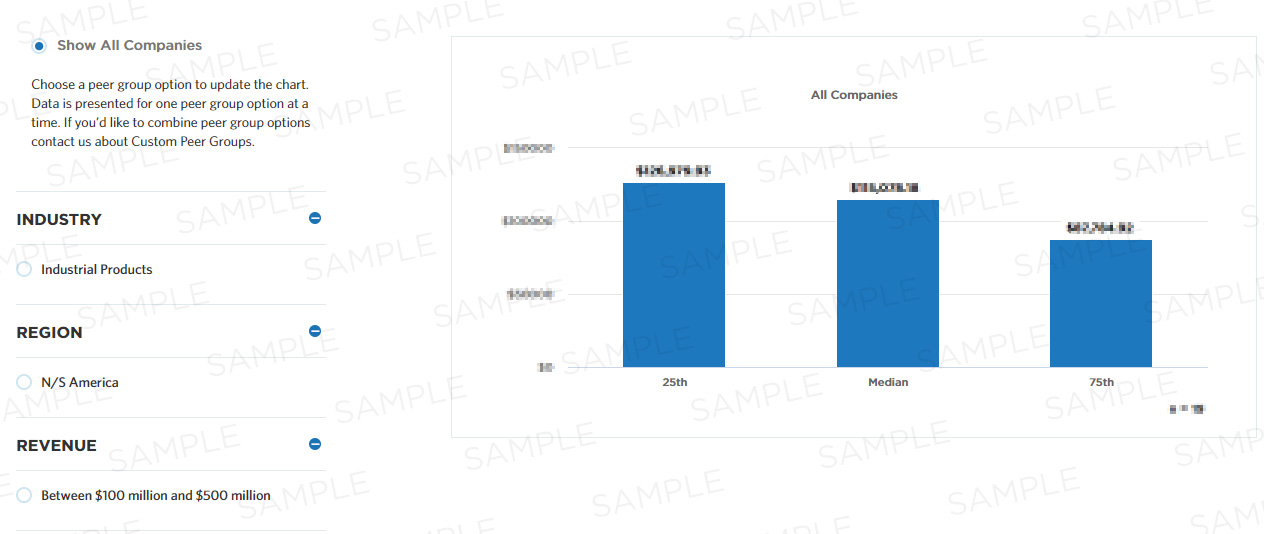Total personnel cost per business entity FTE
This measure calculates total personnel cost per business entity full-time equivalent employee (FTE). Personnel cost refers to employee personnel compensation (salaries and wages, bonuses, overtime and benefits) and fringe benefits (e.g. contributions made towards the employees' government retirement fund, workers compensation, insurance plans, savings plans, pension funds/retirement plans, stock purchase plans), and special allowances such as relocation expenses and car allowances. This Cost Effectiveness measure is intended to help companies understand this cost expenditure related to the process group "Reward and retain employees".
Benchmark Data
| 25th | Median | 75th |
|---|---|---|
| - | - | - |

Compute this Measure
Units for this measure are dollars.
Personnel cost of business entity FTEs / Number of business entity FTEs
Key Terms
FTE - (full-time equivalent employee)
To calculate the number of full-time equivalents employed during the year for each respective process or activity, you must prorate the number of employees and the hours spent performing each process/activity. Assume that a full-time worker represents 40 hours per week. Provide the average number of full-time equivalents employed during the year for each respective process. Include full-time employees, part-time employees, and temporary workers hired during peak demand periods. Allocate only the portion of the employee's time that relates to or supports the activities identified for an applicable process. Prorate management and secretarial time by estimating the level of effort in support of each activity, by process.
For example, a part-time secretary in the finance department for XYZ, Inc. charges all of his time to finance department activities. He works 20 hours per week. The secretary splits his time evenly supporting employees working in the general accounting process and the financial reporting process. Thus, his time should be allocated by process. So, if he works throughout the year and supports these two processes, his time would be split evenly as:
20hrs/40hrs = .5FTE * 50% for general accounting = .25FTE for general accounting
20hrs/40hrs = .5FTE * 50% for financial reporting = .25FTE for financial reporting
Personnel Cost
Personnel cost is the cost associated with personnel compensation and fringe benefits of employees (i.e., those classified as FTEs which includes both full-time and salaried/hourly employees) contributing to each respective process. Personnel cost should include all of the following costs.
Employee Compensation: Includes salaries and wages, bonuses, overtime and benefits.
Fringe: Includes contributions made towards the employees' government retirement fund, workers compensation, insurance plans, savings plans, pension funds/retirement plans, and stock purchase plans. This should also include special allowances, such as relocation expenses and car allowances.
Cost Effectiveness
Cost effectiveness measures are those in which two related variables, one of which is the cost and one of which is the related outcome related to the expenditure are used to determine a particular metric value.
Business Entity
For survey purposes, a business entity is defined as an entity that:
- performs significant aspects of the processes for the surveys identified, or
- is part of a cost or revenue center within the company.
Within your organization, diverse departments may be geographically co-located, with closely integrated operations that form part of one "business entity" which may be a great distance apart. When trying to determine if related parts of your operation should be considered a single business entity, look for the following characteristics:
- Do they operate closely together?
- Do they serve many of the same customers?
- Do they support the same region or product group?
- Do they share any performance measures?
- Is data meaningful at a consolidated level?
Examples of business entity definition:
- A general ledger accounting unit located in Germany has two groups. One performs general ledger accounting for the corporate headquarters, which has three business units. The other group does general ledger accounting for one of the three business units. In spite of their geographic co-location, their roles are substantially different and consolidating their data into a single response would make it less meaningful. Each group should be treated as a separate business entity.
- Three business units within a corporation use a shared services center for accounts payable and expense reimbursement, but are self-supporting for the other financial processes. The best approach is to make the shared services centre a separate business entity for accounts payable and expense reimbursement, and to retain the three original business units for the other financial processes.
- A global manufacturing company has five plant locations, each manufacturing product and each with its own logistics operations. For purposes of completing a manufacturing and logistics survey, they should be treated as five separate business entities.